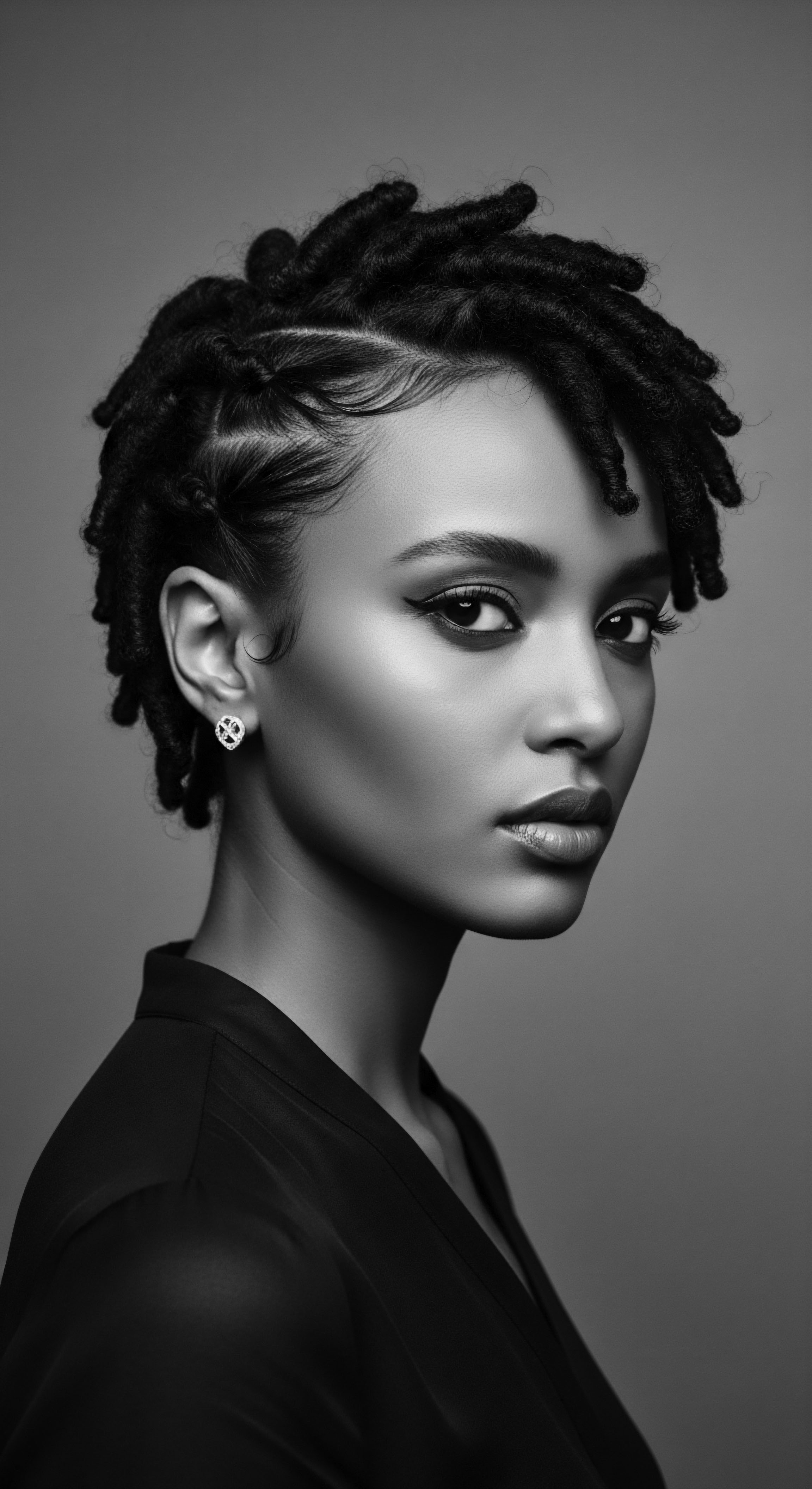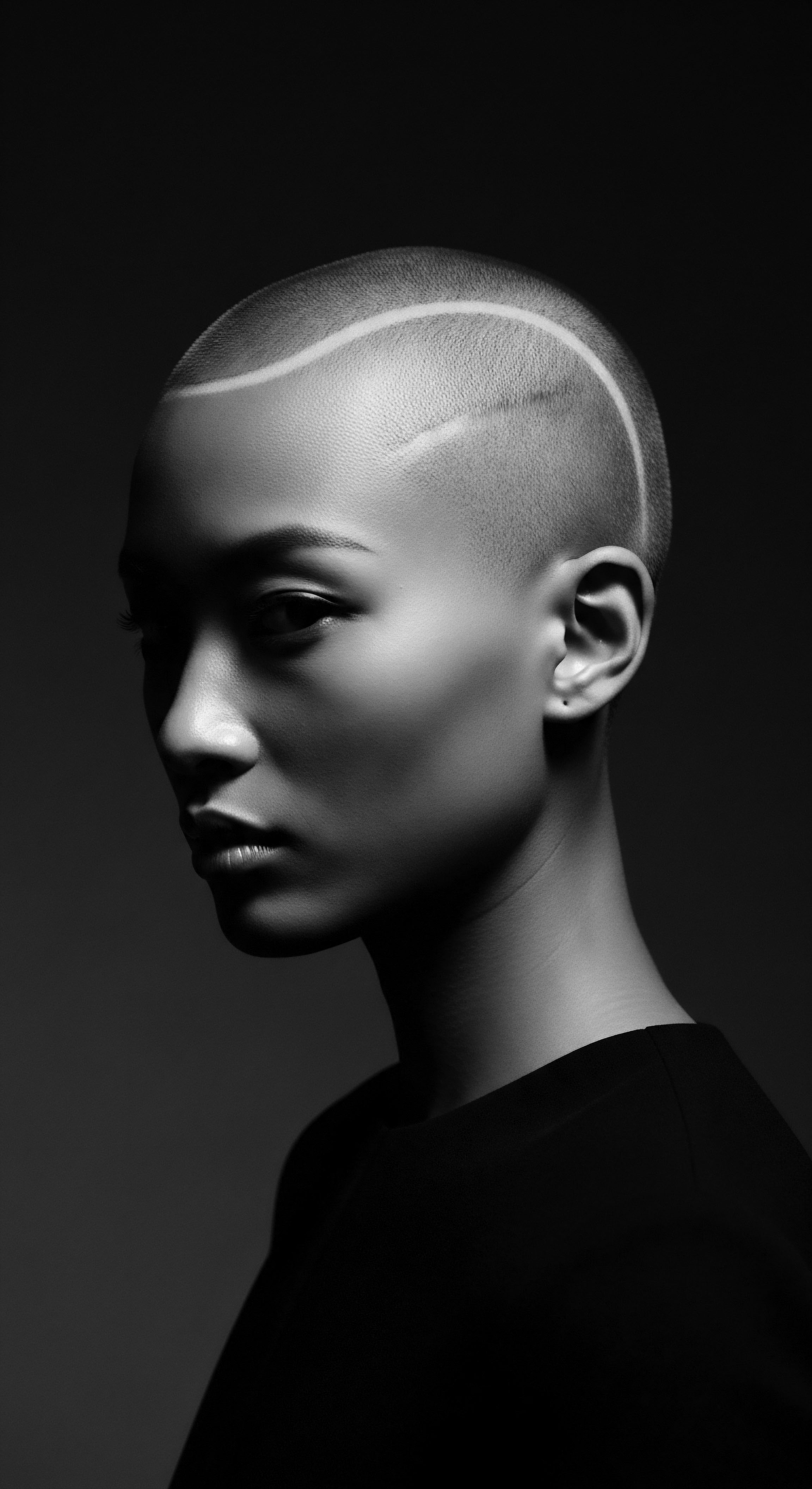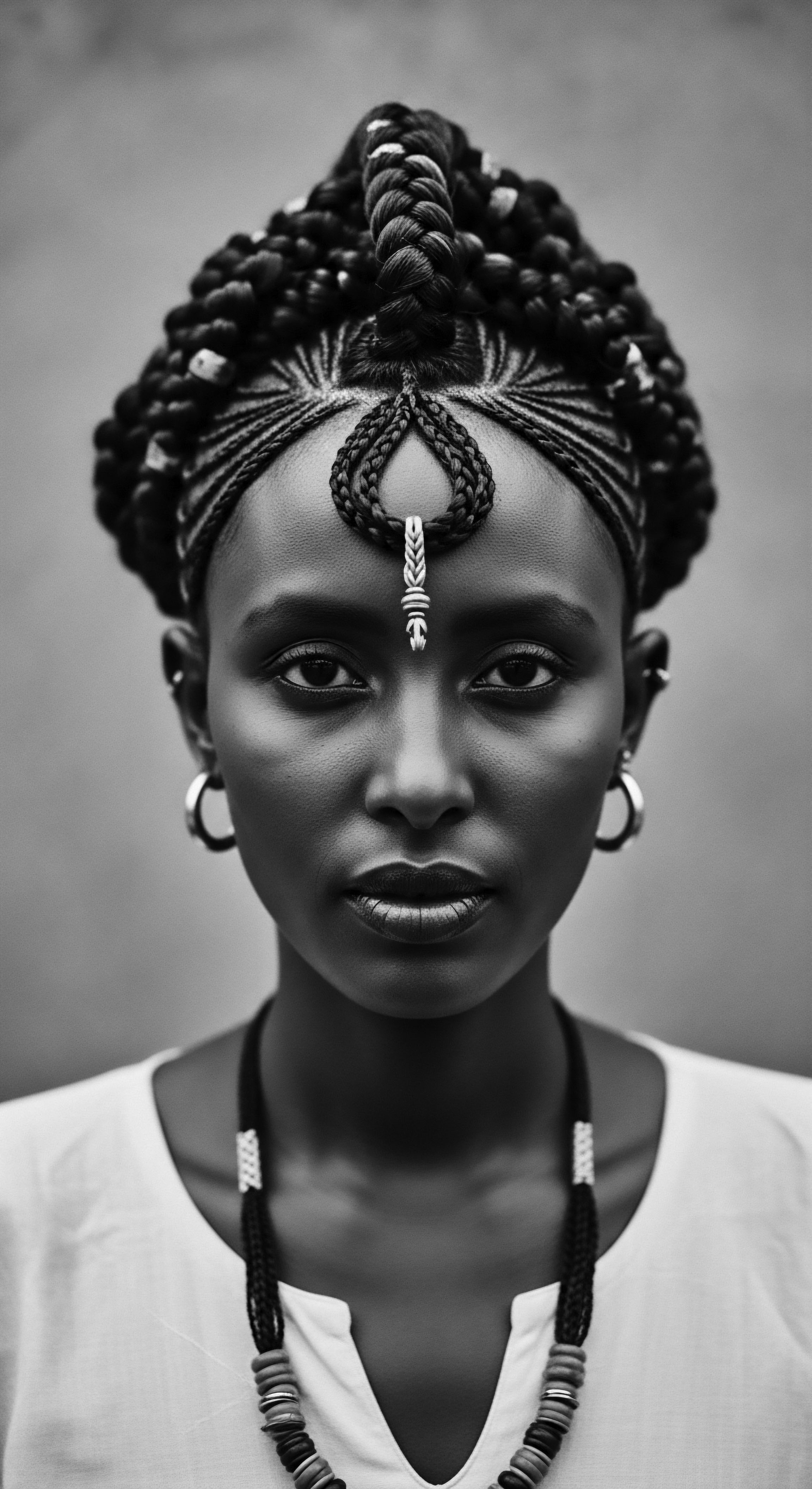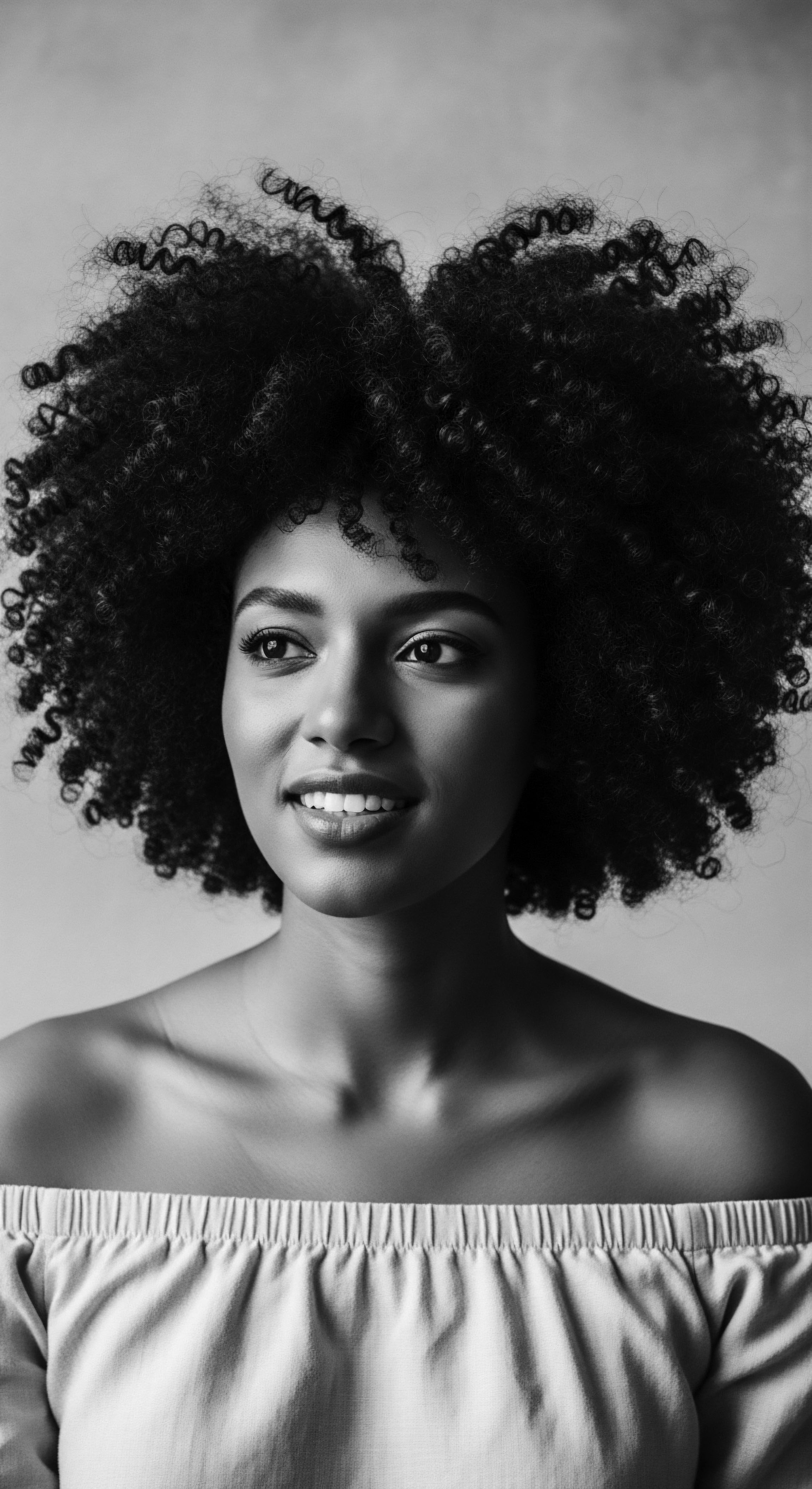
Fundamentals
The Historical Beauty Trade, at its core, represents the intricate web of creation, exchange, and consumption of goods and services fashioned to adorn, groom, and maintain the human form across different eras and cultures. This concept stretches far beyond simple commerce; it encompasses the social, spiritual, and economic relationships that shaped societies through the desire for aesthetic expression. For those of us tracing the lineage of textured hair, particularly within Black and mixed-race communities, understanding this trade illuminates a vibrant yet complex history of resilience, ingenuity, and profound connection to ancestral ways. It reveals how the care for hair, a practice deeply intertwined with identity and spirit, transformed into a powerful cultural currency.
From the earliest human societies, the preparation of ingredients for personal adornment, scalp conditioning, and hair styling formed part of daily rituals. These practices were often communal, passed down through generations, and infused with symbolic weight. The resources utilized for beauty—clays, pigments, natural oils, herbs, and animal fats—were first gathered from immediate environments.
As communities expanded and interactions grew, the sharing of these precious resources, along with the knowledge of their application, began to form nascent trade networks. This exchange allowed for the movement of unique materials, enriching local practices with distant elements.
The early forms of the Historical Beauty Trade were rooted in the availability of natural elements and the ingenious ways ancestral communities transformed them. Think of the ochre used for ceremonial body painting in parts of Africa, or the plant-based dyes for hair found in ancient Egyptian tombs. Each item carried not just a physical value, but also a spiritual or social significance, reflecting the belief systems of the people who sought them.
The understanding of ‘trade’ in this context broadens to include the movement of both tangible items and intangible knowledge. Traditional African hair practices, for instance, frequently involved specific tools and methods passed down through oral tradition. The exchange of these techniques, whether through inter-tribal relations, migration, or even through the forced displacement of peoples, shaped the ongoing narrative of hair care.
The Historical Beauty Trade is a living testament to humanity’s enduring quest for self-expression and connection, woven into the very strands of our shared past.
Consider the simplest elements that formed the bedrock of early beauty practices.
- Oils ❉ Rich plant oils like palm oil or shea butter were indispensable for moisturizing and protecting textured hair, particularly in dry climates. These were often prepared through laborious traditional methods, creating a valuable commodity.
- Clays ❉ Various types of clay served as cleansers, detoxifiers, and protective masks for both skin and hair, with specific properties sought for different needs.
- Herbs ❉ Botanical knowledge was paramount, as specific herbs offered medicinal properties for scalp health, coloring capabilities, or aromatic qualities.
- Fibers ❉ Natural fibers, whether plant-based or from animal hair, were collected and prepared for extensions, braids, and intricate adornments, indicating status or ritual significance.
These foundational ingredients, once locally sourced, gradually became items of exchange, laying the groundwork for more complex commercial systems that would later span continents. The initial intent was often communal well-being and spiritual alignment rather than pure profit.

Intermediate
Moving beyond the foundational, the intermediate understanding of the Historical Beauty Trade delves into the burgeoning sophistication of these exchanges, recognizing how geographical spread, cultural encounters, and evolving social structures began to reshape its meaning. This period saw the emergence of more formalized trade routes, the development of specialized craftspeople, and the increasing recognition of beauty provisions as distinct commodities, rather than merely incidental byproducts of daily life. For textured hair heritage, this era marked both a proliferation of influence and, tragically, the beginning of its devaluation through the lens of colonial power structures.
As trade networks expanded, particularly across ancient civilizations and later through transcontinental routes, new ingredients, tools, and stylistic ideas flowed between communities. The Silk Road, for example, did not transport only spices and textiles; it facilitated the exchange of botanical knowledge, aromatic resins, and mineral pigments that influenced beauty practices across Asia, Africa, and Europe. This interchange meant that a specific hair oil used for its luster in one region could gain favor hundreds of miles away for its protective qualities against environmental elements, enriching the collective understanding of natural resources.
The significance of hair in many African societies, for example, was so profound that hairstyles could convey a person’s Family Background, Social Status, Spirituality, Tribe Affiliation, and even Marital Status (Omotos, 2018). Such detailed meanings embedded in hair meant that hair care was never a superficial activity; it was a deep cultural practice. The materials used in these practices, such as specialized combs, unique adornments like cowrie shells and beads, or specific plant-based cleansers, were integral to maintaining these elaborate expressions. These items, when traded, carried with them the echoes of their cultural origins, even as their meaning might shift in new contexts.
The pre-colonial African continent possessed sophisticated internal trade networks for personal care items long before extensive European contact. Resources like shea butter, indigenous oils, and rare earth pigments were exchanged between different linguistic groups and kingdoms, creating a dynamic internal economy of beauty. These exchanges were not simply about transactions; they were about sharing and adapting traditions. The value of these items was often tied to their efficacy and their cultural significance, rather than solely their scarcity.
The intermediate phase of the Historical Beauty Trade illustrates how the intimate world of personal care began to intersect with the grand narratives of global commerce, shaping both markets and identities.
The profound shift arrived with the transatlantic slave trade and colonialism. This period introduced a brutal rupture in ancestral hair practices and the beauty trade as it was known. Enslaved Africans were often subjected to forced hair shaving upon disembarkation from slave ships, a deliberate act to strip them of their identity and cultural connections (Matjila, 2020, p.
30). This act disrupted the ancestral beauty trade not just in its physical manifestations of tools and products, but in its very spiritual and social significance.
Yet, even within the confines of enslavement, ingenuity persisted. For instance, slave women in the Americas found covert ways to maintain practices related to hair and survival. As detailed by Carney (2001), an oral tradition in parts of South America suggests that enslaved African women introduced rice by hiding grains within their braided hairstyles. This seemingly simple act of preservation demonstrates a profound connection between hair, ancestral knowledge, and economic survival, a hidden trade of sustenance enabled by the very structure of textured hair.
This resistance, while not a commercial trade in the conventional sense, underscores the enduring adaptive spirit of beauty practices in the face of adversity. The very act of caring for one’s hair, or weaving something precious into it, became a form of commerce in resilience and the preservation of heritage.
The imposition of Eurocentric beauty standards during colonialism further impacted the beauty trade, shifting demand towards products that altered textured hair to conform to European ideals. This created a new market, often dominated by non-African producers, that undermined traditional practices and fostered complex relationships with self-perception within Black communities. This historical imposition continues to cast a long shadow over the modern beauty industry, making the study of the Historical Beauty Trade for textured hair a critical examination of power, aesthetics, and cultural continuity.
| Era/Context Pre-Colonial Africa |
| Traditional Ingredients & Usage Shea Butter and Palm Oil ❉ Used for moisturizing, sealing, and protective styling. Often locally harvested and prepared. |
| Shift & Commercial Impact Local and regional exchange networks. Value tied to efficacy and cultural significance. Limited external commercialization. |
| Era/Context Colonial Era / Transatlantic Slave Trade |
| Traditional Ingredients & Usage Forced denial of traditional ingredients; use of improvised, often harmful, substitutes like axle grease or kerosene due to lack of access. |
| Shift & Commercial Impact Disruption of traditional economies. Emergence of new demands driven by imposed aesthetic norms; limited access to ancestral remedies. |
| Era/Context 19th & 20th Century (Post-Emancipation) |
| Traditional Ingredients & Usage Early Black entrepreneurs adapt traditional knowledge. Introduction of products like hot combs and chemical relaxers for straightening. |
| Shift & Commercial Impact Development of a distinct "Black beauty market." Formation of racial enclave economies around salons. Commercialization shifts towards altering texture. |
| Era/Context Late 20th Century to Present |
| Traditional Ingredients & Usage Resurgence of interest in natural oils, herbs, and protective styles. Global sourcing of traditional African ingredients. |
| Shift & Commercial Impact Reclamation of ancestral practices. Increased demand for natural products. Debates on authenticity and ownership in the global beauty market. |
| Era/Context Understanding these shifts provides insight into the enduring adaptability of textured hair care and its journey through changing commercial landscapes. |

Academic
The Historical Beauty Trade represents an academic field of inquiry, a precise delineation of the complex socio-economic, cultural, and political dynamics that have historically governed the production, distribution, consumption, and symbolic valuation of products and services intended for human aesthetic enhancement and somatic care. This scholarly interpretation expands beyond mere transactional activity, embracing the profound implications for identity construction, social hierarchy, and the commodification of lived experience, particularly within the contexts of textured hair heritage, Black, and mixed-race experiences. It examines how physical adornment, deeply rooted in ancestral practices, became entwined with global commerce and colonial power, shaping beauty standards and economic pathways across centuries.
This definition necessitates an interdisciplinary lens, drawing insights from anthropology, history, sociology, economics, and even material science. Anthropological studies reveal the intrinsic connection between beauty rituals and spiritual beliefs in pre-colonial African societies, where hair functioned as a conduit to the divine or a marker of social standing (Matjila, 2020, p. 19; Omotoso, 2021).
The systematic documentation of hairstyles and their cultural meanings across various West African communities, such as the Wolof, Yoruba, and Mende, provides a clear framework for understanding hair as a complex communication system, one that directly influenced the earliest forms of beauty “trade” through cultural exchange and knowledge transmission (Johnson & Bankhead, 2014, p. 87; Omotoso, 2021).
Economically, the Historical Beauty Trade demonstrates how resources, initially gathered and processed communally, transitioned into structured markets. The trade of specific hair adornments, such as shells, beads, or precious metals, facilitated early forms of inter-communal commerce. As global empires arose, these localized exchanges became integrated into larger, often exploitative, mercantile systems.
The valuation of indigenous ingredients, previously tied to their functional and symbolic significance, began to be dictated by external demands and colonial extraction. This re-contextualization profoundly altered the indigenous beauty economy.
A rigorous examination of the Historical Beauty Trade’s evolution requires confronting its intersection with oppressive systems. The transatlantic slave trade, a period of immense suffering, offers a stark illustration of how beauty practices and the trade of hair were weaponized. The systematic shaving of enslaved Africans’ hair upon their arrival in the Americas, ostensibly for hygiene, represented a deliberate act of stripping identity and disconnecting individuals from their ancestral heritage, undermining the very ontological significance of hair (Matjila, 2020, p.
30; Tshiki, 2021). This act was a calculated severing of the physical manifestations of their past, disrupting the cultural beauty trade in its most profound sense.
The Historical Beauty Trade, when viewed through a critical lens, reveals a complex interplay of power dynamics, cultural resilience, and economic agency across generations.
Yet, even within this severe rupture, a powerful, albeit subtle, form of the Historical Beauty Trade persisted—one of resilience and adaptation. Consider the resourceful practice of enslaved African women hiding rice grains within their braided hairstyles during the transatlantic journey or on plantations to ensure future sustenance (Carney, 2001, p. 337). This practice, documented through oral histories in places like colonial Brazil and South Carolina, transcends a simple act of survival.
It represents a vital, clandestine “trade” of knowledge and resource, mediated by the unique attributes of textured hair itself. The intricate coiling and braiding, deeply rooted in West African traditions, served not just as aesthetic expression, but as a practical means of transporting precious seeds. This ingenious adaptation transformed hair into a vessel of hope and an agent of future prosperity, creating an enduring legacy of intergenerational agricultural knowledge. The hair, in this instance, became both a canvas for cultural memory and a conduit for economic and physical survival, a poignant example of the implicit historical beauty trade.
Following emancipation, the landscape of the Historical Beauty Trade for Black and mixed-race communities shifted dramatically. The emergence of a distinct Black beauty industry, pioneered by figures like Madam C.J. Walker and Annie Turnbo Malone, showcased profound entrepreneurial spirit (Jones, 2010; Wingfield, 2008).
These women, many of whom had intimate understanding of textured hair needs from their own experiences, developed and marketed products specifically for Black consumers. Their success was not merely economic; it created avenues for economic self-sufficiency for thousands of Black women who became agents and salon owners, fostering a “racial enclave economy” (Wingfield, 2008).
The significance of these enterprises extends to their role in shaping community standards of grooming and beauty, often in response to prevailing Eurocentric ideals that deemed natural Black hair as “unprofessional” or “undesirable” (Johnson & Bankhead, 2014; Thompson, 2009). The Historical Beauty Trade during this era became a battleground for identity, where the desire for social mobility intersected with questions of cultural pride. While products like hair relaxers and hot combs offered conformity, they also sustained an industry that reflected complex internal debates within Black communities about aesthetic self-determination.
Indeed, historical research indicates that the practice of hair straightening, while often critiqued, also signified self-respect and good grooming for many Black women, complicating any simplistic interpretation of its motivations (Jones, 2017). This aspect of the trade reveals the intricate decisions individuals and communities faced regarding appearance and survival.
The re-emergence of the Natural Hair Movement in the late 20th and 21st centuries represents a contemporary continuation of the Historical Beauty Trade, now focused on reclaiming ancestral aesthetics and practices. This movement has spurred a global market for natural hair products and services, often drawing on traditional African ingredients and techniques. However, it also presents new complexities, including questions of appropriation, ethical sourcing, and the ongoing challenge of equitable ownership within a beauty industry still largely dominated by non-Black entities.
The ongoing dialogue surrounding the CROWN Act in the United States, which aims to ban discrimination based on hair texture and protective hairstyles, underscores the persistent social and economic implications of historical beauty standards and trade practices on Black individuals (Tshiki, 2024). This legislative effort highlights how the legacy of the Historical Beauty Trade continues to influence contemporary battles for equity and cultural affirmation.
To fully grasp the meaning of the Historical Beauty Trade, one must acknowledge its dynamic nature, its capacity to adapt, and its deep connection to the human spirit’s yearning for expression and belonging. It is a historical testament to the enduring human interest in the presentation of self, profoundly shaped by forces of commerce, culture, and power.
Specific examples of how this trade was woven into cultural fabric ❉
- Hair as a Spiritual Conduit ❉ In many West African traditions, hair was believed to carry a person’s Spiritual Essence and served as a direct line to ancestral wisdom and the divine. Specific rituals involving hair, often conducted by revered elders, were performed for significant life events, linking personal care directly to spiritual well-being and community connection (Matjila, 2020).
- Communal Hair Braiding as Social Capital ❉ Across numerous African societies, communal hair braiding was not simply a stylistic practice but a deeply social activity. It provided a setting for sharing stories, transmitting history, and strengthening social bonds, creating a valuable, non-monetary economy of shared labor, trust, and cultural continuity (Omotoso, 2021). The time and skill involved in these sessions represented a form of social currency.
- The Scarcity and Ingenuity of Wartime Care ❉ During periods of conflict or enslavement, when access to traditional tools and ingredients was severely limited, creativity flourished. Enslaved individuals would repurpose available materials, using animal fats or even kerosene to care for their hair, demonstrating an incredible adaptive capability and an enduring will to maintain personal appearance and cultural identity (Heaton, 2021). This resourceful adaptation highlights an implicit, survival-driven “trade” of knowledge and makeshift resources.
The ongoing research into these historical nuances provides deeper insights into the enduring relationship between textured hair, its heritage, and the broader commercial forces that have shaped its story.

Reflection on the Heritage of Historical Beauty Trade
As we contemplate the expansive tapestry of the Historical Beauty Trade, especially through the lens of textured hair, we witness more than a succession of transactions or evolving styles. We perceive a profound meditation on humanity’s yearning for connection, for meaning, and for self-expression through the very fibers that crown our beings. This enduring legacy is a living testament to ancestral wisdom, a quiet affirmation that the care of hair transcends superficiality to touch the very core of identity and spirit.
The journey from elemental biology and ancient communal practices, through the tender threads of care passed across generations, to the unbound helix of identity shaping future narratives, speaks to a deeply resonant truth ❉ our hair carries stories. It holds the whispers of elders who taught the alchemy of natural oils, the strength of those who braided sustenance into strands, and the vibrant defiance of communities who insisted on their inherent beauty despite oppressive gazes. The beauty trade, in its true historical sense, has always been about more than commerce; it has been about cultural continuity, about quiet acts of rebellion, and about the reclamation of self.
This collective memory, embodied in every curl, coil, and wave, invites us to recognize the profound agency of individuals and communities in defining their own standards of beauty, even when external forces sought to impose different ideals. It prompts us to honor the ingenuity of those who cultivated solutions from their environments, creating a market rooted in genuine need and deep-seated cultural reverence. The Historical Beauty Trade, then, is not merely a subject for academic study; it is an invitation to engage with our own heritage, to understand the ancestral currents that flow through our modern practices, and to celebrate the resilience of textured hair as a symbol of identity.
It encourages us to walk gently into the future, carrying the wisdom of the past, understanding that the pursuit of beauty, when grounded in authenticity and respect for one’s lineage, becomes a potent force for well-being and liberation. The soul of a strand truly holds the echoes of generations, a continuous narrative of beauty, spirit, and survival.

References
- Carney, Judith A. 2001. “‘With Grains in Her Hair’ ❉ Rice in Colonial Brazil.” UCLA Department of Geography’s 29 (3) ❉ 337–55.
- Heaton, Sarah. 2021. “Heavy is the Head ❉ Evolution of African Hair in America from the 17th c. to the 20th c.” Library of Congress.
- Johnson, Tabora A. and Teiahsha Bankhead. 2014. “Hair It Is ❉ Examining the Experiences of Black Women with Natural Hair.” Open Journal of Social Sciences 2 (1) ❉ 86–100.
- Jones, Geoffrey. 2010. “Globalization and Beauty ❉ A Historical and Firm Perspective.” EURAMERICA 41 (4) ❉ 885–916.
- Matjila, Chéri R. 2020. “The Meaning of Hair for Southern African Black Women.” University of the Free State.
- Omotoso, Sharon Adetutu. 2021. “Gender and Hair Politics ❉ An African Philosophical Analysis.” IASR Journal of Humanities and Social Sciences 1 (1) ❉ 36–42.
- Thompson, Cheryl. 2009. “Black women, beauty, and hair as a matter of being.” Women’s Studies 38 (8) ❉ 831–56.
- Tshiki, Nonkoliso Andiswa. 2021. “African Hairstyles – The “Dreaded” Colonial Legacy.” The Gale Review.
- Tshiki, Nonkoliso Andiswa. 2024. “The Power of Hair in African Folklore ❉ Rituals and Traditions.” Bebrų Kosmetika.
- Wingfield, Adia Harvey. 2008. “Doing Business With Beauty ❉ Black Women, Hair Salons, and the Racial Enclave Economy.” Ph.D. diss. University of Texas at Austin.
